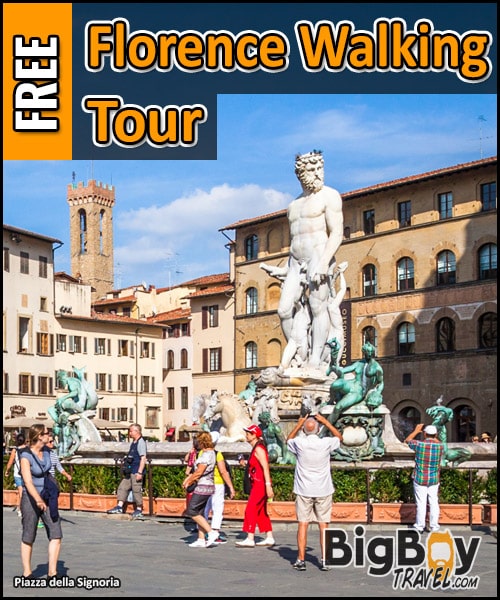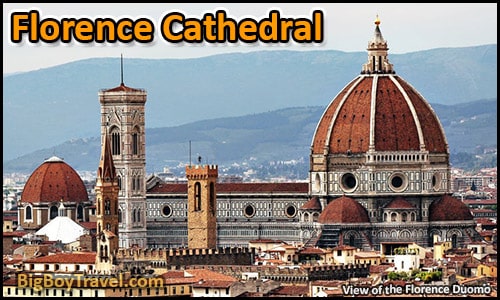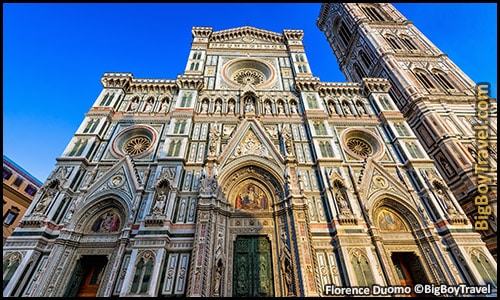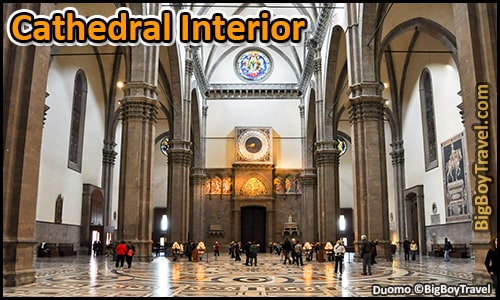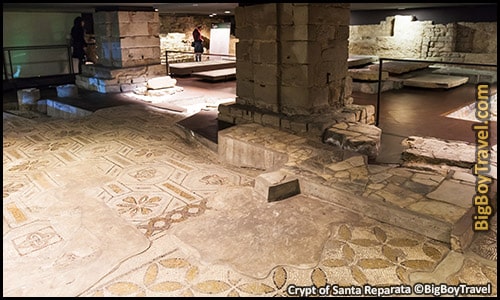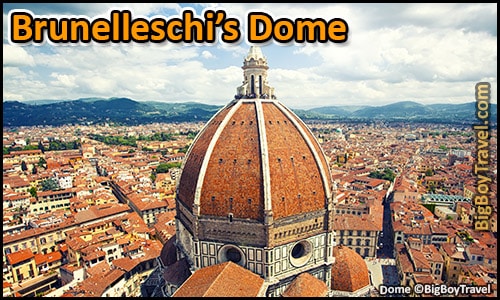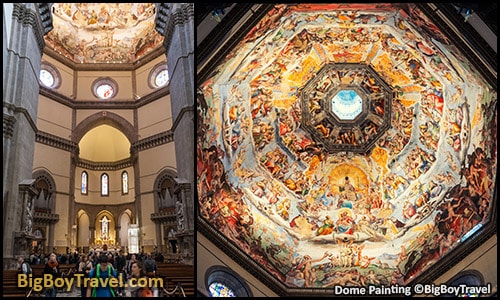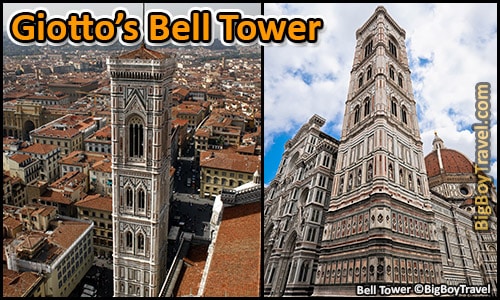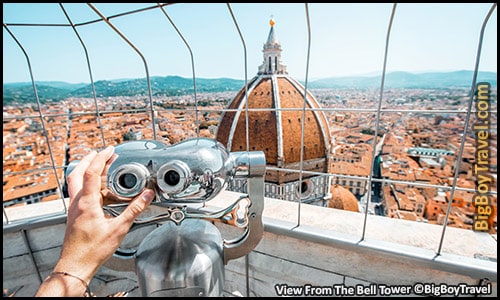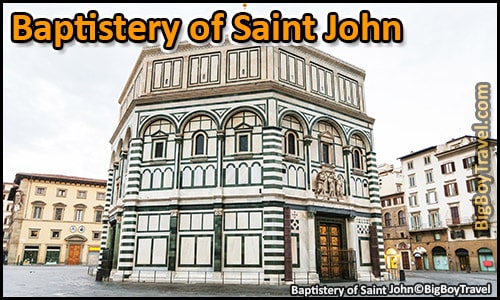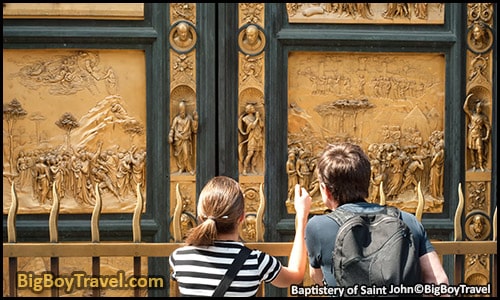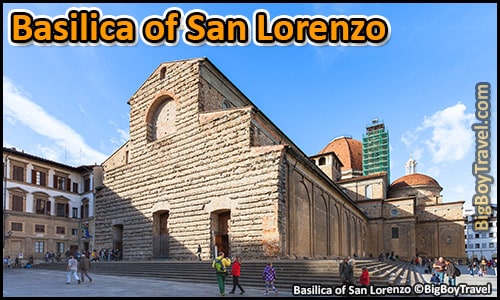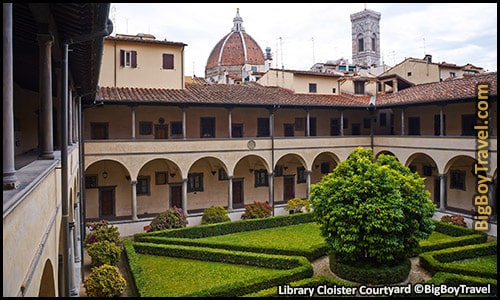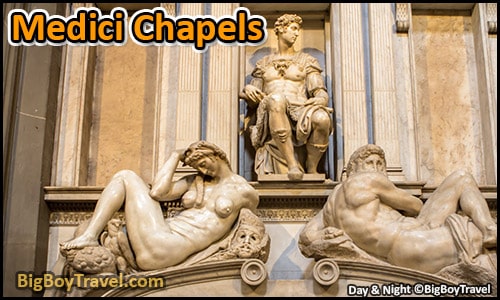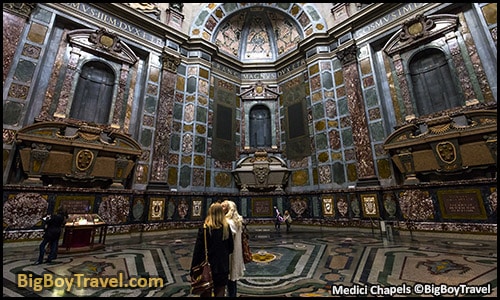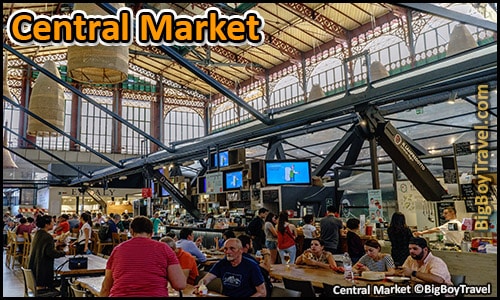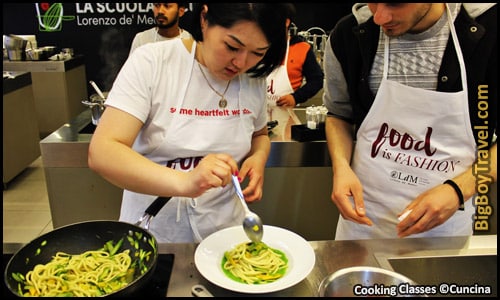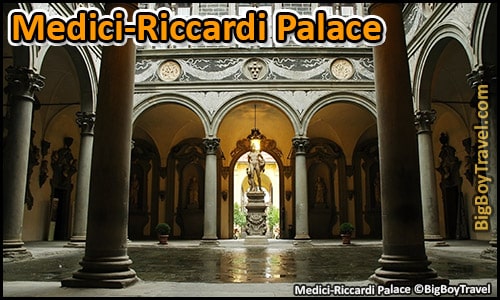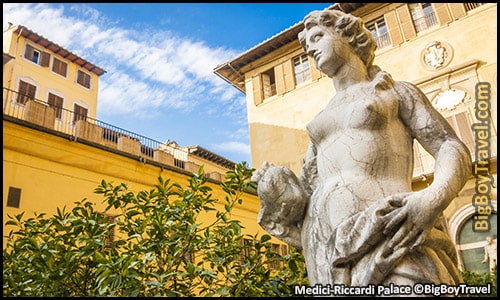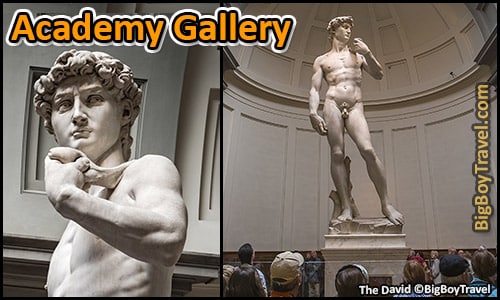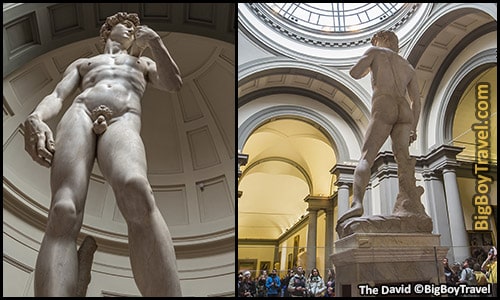Europe > Italy > Florence > Free Florence Walking Tour
Free Florence Walking Tour
Location: Florence’s City Center
Cost: Free (optional costs below)
Style: Do-It-Yourself Walking Tour (Self Guided)
Start: Florence Cathedral (Duomo)
End: Republic Square
Walking Distance: 2.2 Miles
Time Required: 70 Minutes for the walk (average time with sights is 6 hours, assume 1+ hours per museum which can take 2-3 days to fully tour everything)
Fun Scale: 10 out of 10
Overview of Central Florence:
Not only is central Florence the heart of town, but since the 1500s it was also the heart of the Italian Renaissance. While many of Florence’s neighbors never recovered from plagues and famines, thanks to its river access, powerful military, and ruthless Medici rulers, Florence grew into a European powerhouse in the Age of Enlightenment. We hope to give you a glimpse of the town’s glory on this free Florence walking tour.
While previously settled lightly by the Goths, a formal Roman town was established here by Julius Ceasar in 59BC. Called Florentia after the Roman Goddess of flowers Flora, they symbol of town is the Lilly. In 285 Emperor Diocletian established in Florence the headquarters of all of Tuscia. Their power grew in the 300s when Etruscan villages of Volterra and Chiusi were defeated and Roman colonies of Pistoia and Lucca grew making Florence also in charge of Umbria.
Villanovan (entruscan) settlements since 800BC, Etruscan walls of Fiesole 8th century BC settled recorded as a town in 283 BC Faesulae
goths attack in 406 and are beat, Byzantines attack in 553, Lombards conquer Florence in 570, Lombards rule from Lucca, Lombards name Saint John Protector of Florence, Charlemagne, founder of the Holy Roman Empire, was in Florence at least 2 times: 781 and 786.
Florence is attacked by Vikings and Magyars (Hungarians) • 854. Lothair brought together the two counties of Florence and Fiesole. 978 florence becomes Tuscan capital
How To Divide Your Time In Florence:
You can breeze through central Florence pretty quickly if needed whizzing through the city center and viewing all of the walking tour sights from the outside in under two hours. Most visitors following our free Florence walking tour map average between 6-7 hours to get their fill, although it can take 2-3 full days to see every stop in full detail.
This 6-7 hour mark assumes you will spend 1-2 hours walking around town, 90 minutes at the Duomo & Bapistry (book ahead), 30 minutes seeing the David (book ahead), 1 hour at both the Bargello & Uffizi Museums (book ahead), plus time to eat. See a theme? Book your entrance tickets ahead of time you can end up wasting all day in line, which a lot of tourists do.
If you don’t want to make your day any longer than 6-7 hours, you are going to have to make some tough choices on which museums you want to tour. Of the two that take the hour, we like the Bargello the most and find the Uffizi to be a bit overrated. On a tight schedule, we even prefer to skip the Uffizi altogether and spend that time instead climbing to the top of the dome at the Florence Cathedral (book ahead).
Prioritizing your stops and limiting how much time you spend touring in a day is important as the evenings in Florence as best enjoyed at a slow pace. The hours leading up to dusk are meant for watching the sunset over town while sipping a local wine, digging into a rare Florentine steak, or taking a relaxing passeggiata stroll.
Free Florence Walking Tour:
1. Florence Cathedral (Duomo):
About The Duomo: Officially called the Cathedral of Santa Maria of the Flower (del Fiore), Florence’s Cathedral (Duomo) is the most monumental landmark in town. Before the current church was started in 1296, the Romanesque Cathedral of Santa Reparata sat here dating back to the Gauls in the 400s. Because the architect died in 1310, work slowed for 30 years until the survivors of the Plague of 1348 revived the project.
The delightful white, pink, and green striped marble wrapping the exterior of the massive Florence Cathedral is stunning. We love staring at the colorful patterns on the facade especially while inspecting the detailed statues and three large bronze front doors. The powerful green doors were cast from 1899-1903 and represent scenes from the life of the Virgin Mary whom the cathedral is dedicated to.
Above it all, the masterpiece of the Florence Cathedral is the massive double-shelled dome designed by Brunelleschi in 1420 and built without scaffolding. We will see the dome (which we suggest climbing) and the interior of the church in greater detail next on this free Florence walking tour.
Guided Tours: For an additional 20€ you can get a guided tour of the Baptistery of St. John, the Cathedral of Santa Maria del Fiore and the Opera del Duomo Museum with priority access to the sights and the Duomo’s Hidden Terraces. Online Tickets & Dome Reservations: Here. Guided Tour Info: Here. Themed Tours Info: Here. Cathedral Website: Here.
Time Required: 10-15 minutes to see the outside of the Cathedral (2-3 hours with all Duomo sights).
2. Duomo Interior:
About The Duomo: If you have already been inside the grand cathedrals in Siena, Venice, or Rome, it can be easy to find the interior of Florence’s Duomo to be quite boring in comparison, but it is worthwhile. As you enter the mostly barren massive church, it can be overwhelming to grasp how large it really is inside. A majority of the enormous Florence Cathedral is empty with a geometric patterned marble floor and large sequoia-sized stone pillars holding up the roof. Most of the Medieval artifacts from the interior that still survive are on display at the Duomo Museum which we will stop at later on this free Florence walking tour.
The first of the few interior highlights of the Florence Duomo is the great liturgical clock above the bronze front door. This Medieval, single-hand clock from 1433 is very rare as it uses Old Italian Time which is much different than today’s clocks. In Old Itlain Time there were still 24 hours in a day, but they were divided evenly between night and day each with getting 12, but the length of the hours varied throughout the year with more or less daylight.
Above the clock, is a rose window called Christ Crowning Mary As Queen from the 1300s which is mirrored by the Coronation of the Virgin designed Donatello in the 1400s at the other end of the cathedral. Our favorite artwork in the church is the View of Florence in 1465 by Domenico di Michelino which gives us a great cityscape mixed with scenes from local author Dante’s novel The Divine Comedy. In the middle of the church are a canvas equestrian paintings from the 1800s copied from a famous fresco by Andrea del Castagno in 1456.
There are stairs to go down below the marble floor of the Florence Cathedral and into the Crypt of Santa Reparata. We find the crypt to be fascinating as you can see mosaic floors from the ancient Church Santa Reparata. This old world church from the 400s drastically predates the Duomo built over the top of it stating in the late-1200s. The floor shows the names of the 14 donors of Latin origin who financed the construction of Santa Reparata. Foundations of homes and pieces of the original Roman wall have also been found under the Duomo.
Tombs in the church include those of Bishop Zenobius of Florence, painter Giotto di Bondone, Pope Nicholas II, Pope Stephen IX, and the designer of the Florence Cathedral’s dome Filippo Brunelleschi. Next on this free Florence walking tour, we will inspect Brunelleschi’s famous dome.
Cathedral Visiting Hours: Monday-Friday 10am-5pm ; Saturday 10am-430pm; Sunday 1:30-4:45pm. Cost: The interior of the Florence Duomo is free, however, a Cumulative Ticket for all Museum sites valid once per site over 72 hours is 18€ and allows you to skip the lines. You can also pre-book a Dome Climb timeslot. Dress Code: As it is an active church, access with bare legs and shoulders, sandals, hats, and sunglasses is not permitted. Bulky backpacks and bags are not allowed.
Clock Tour: Can take a 30 minute guided tour of the inner workings of the clock by special request for an additional 12€ fee. Crypt Tour: Are self-guided and included in the Duomo combo ticket. Themed Tour Info: Here. Cathedral Website: Here.
Time Required: 15-20 minutes to tour the inside of the Cathedral (2-3 hours with all Duomo sights).
3. Brunelleschi’s Dome:
About Brunelleschi’s Dome: The concept for the iconic dome was started by the Florence Cathedral builders in 1296, but this masterpiece of the church wasn’t realized until the designs of Brunelleschi (previous a goldsmith) in 1420. Brunelleschi had the idea of creating the massive dome with an octagonal double-shell to support the weight as the use of buttresses-style of their French rivals was forbidden in Florence. To prove his design, Brunelleschi built a 15-foot-tall and 30-foot-wide brick model of the dome inside the nave of the unfinished church.
Astonishingly without scaffolding, the massive dome was finished in just 26 years (1420-1446) and became a symbol of Florence’s power. At 375.5 feet (114.7 meters) tall and 138.5 feet (42.2 meters) wide the marvelous dome is even bigger than Saint Peter’s Basilica in Rome. It was the first major Cathedral dome completed since ancient Roman times and is within a foot in size of Rome’s Pantheon.
Brunelleschi finished the dome and had just started on the marble cupola lantern capping the top when he died. In 1461, 15 years after his death, the marble lantern was finished and adorned with a 7.5 foot wide (2.3 meters) copper ball weighing 18 tons. In 1492 the large golden ball was famously struck by lightning as Lorenzo de Medici died. Then later, in 1601 the orb was stuck again and fell off crashing into the ground where there is now a white marble circle marker in the pavement behind the cathedral.
The cupola lantern today serves as a viewing platform with sweeping views almost 40 stories above Florence. To reach the viewing platform you must take a slightly claustrophobic but rewarding climb of 463 steps (no elevator) up to the top which takes around an hour round trip. During your climb up (book in advance) you will get a unique insight on the inner workings of the double-layers design and an up-close perspective of the wonderful paintings lining the bottom of the dome.
As requested by Cosimo I de’ Medici, an enormous scene from the Bible’s Last Judgement was painted on the underside of the dome starting in 1568 by Giorgio Vasari’s and completed by Federico Zuccari in 1579. Seeing the 100-foot-wide mural while climbing the rafters of the dome is far more impressive than only looking up as it from the cathedral floor far below.
Dome Climbing Hours: Monday-Friday 8:30am-7pm; Saturday 8:30am-5pm; Sunday 1-4pm. Closed on the first Tuesday of each month. The neighboring bell tower can also be climbs, is almost as high, has extended hours, and a shorter line if you forget to book ahead. Dome Climbing Cost: A Combo Ticket for all Museum sites valid once per site over 72 hours is just 18€. Duomo Climb Entrance: The entrance is at the Almond Door (Porta della Mandorla) at the Northside of the Cathedral. There is no ticket purchasing booth at the dome entrance so buy online beforehand.
Mandatory Reservations: There are only 125 people allowed to climb up every 30 minutes so even if you get in line early you will often wait in line for hours which makes booking a timeslot reservation to climb the Cathedral’s dome basically mandatory. Skip-the-line reservations are free when made during your booking of the Cumulative Ticket. Online Tickets & Reservations: Here. Dome Website: Here.
Time Required To Climb The Dome: 60 minutes round trip to climb the dome and return with a pre-booked reservation, arrive 15 minutes early (1-5 hours in line if you don’t book ahead).
4. Giotto’s Bell Tower (Campanile):
About The Bell Tower: 276 feet tall and 414 steps to top (no elevator). slender bell tower, originally considered the toughest challenge, more than the dome. The design matches the icon white, green and pink marble of the Florence Duomo’s facade.
Bell Tower Climbing Hours: Daily 8:15am-7pm. Cost: A Combo Ticket for all Museum sites valid once per site over 72 hours is 18€ and allows you to skip the non-ticketed visitors. Online Tickets & Reservations: Here. Bell Tower Website: Here. Time Required: 45-60 minutes round-trip to climb the bell tower (go early or late to avoid midday lines).
5. The Baptistery of Saint John (Battistero di San Giovanni):
About The Duomo: named after John the Baptist who is celebrated in Florence every June 24th. in 1401 the Calimala Merchants’ Guild had a competition for the doors from the Bible showing the sacrifice of Isaac who had to kill his own son for God before being stopped by an angel. Ghiberti won
Women’s gallery and Attic tours give you magnificent views of the beautiful gold mosaics of the dome and marble inlays of the floors. Travel back in time to the beginnings of Florence with this guided tour into one of the symbols of the city – the Baptistery. A masterpiece of Romanesque architecture, its dome is entirely covered in Byzantine mosaics. With this special itinerary through the women’s gallery (matroneum) you will see the splendid mosaics and inlaid marble floors from an extraordinary point of view. By climbing to the attic you will discover the secrets of the architecture of the roof, which inspired Brunelleschi’s famous Cathedral Dome. Your tour includes the visit to the Cathedral of Santa Maria del Fiore.
.The northern gate of the Roman town (PORTA AD EPISCOPI) sat near the NE corner. There was a small Roman bath (BALNEUM MARTIS) near the gate which they have found two mosaic floored rooms.
stately home (Domus) dating back to the first century AD, from which pieces of mosaic floors were found below the Baptistery. To the SW part of the square they have also found the foundations of shops (tabernae), and courtyards (cavea).
Woman’s Galley Tours: Monday, Wednesday, & Friday 4:30-6pm. Also includes brief Cathedral tour and access to the other complex sites once each within 72 hours. Woman’s Galley Tour Booking: Here. Dress Code: As it is an active place of worship, access with bare legs and shoulders, sandals, hats, and sunglasses is not permitted. Bulky backpacks and bags are not allowed.
6. Basilica of San Lorenzo & Cloister Courtyard:
About The Basilica of San Lorenzo: Built outside of Florence’s original city wall, the timeless Church of San Lorenzo was consecrated in 393 by the first bishop of Florence, Saint Zenobius. The basilica is named after the early-Christian Saint Lawrence who was martyred by order of Roman Emperor Valerian in 258AD and burned alive on a grill.
The Church of San Lorenzo was the official Cathedral of Florence until the 800s when the bones of Saint Zenobius were moved inside the walls to Santa Reparata Church (site of today’s Duomo) to protect them from Hungarian invasions. It’s said that during the transfer, his bones touched an elm tree and it became leafy in the dead of Winter. A Medieval column with a cross (1384) next to the Baptistery of Saint John marks the former location of the famed elm tree.
Shortly after Gherardo of Burgundy (Bishop of Florence) was elected as Pope Nicholas II in 1058, San Lorenzo received a Romanesque makeover. In the early-1100s, the powerful Matilde di Canossa (Duchess of Tuscany) lived near the Basicila which helped to keep it important. As it was their family’s parish, Giovanni di Bicci de’ Medici (founder of the family bank) financed the re-building of San Lorenzo in 1419 designed by Brunelleschi (same guy as the Duomo’s dome).
Completed in 1461 (15 years after Brunelleschi’s death) the church included an all-new brightly lit nave on the front, elegant two-story loggia courtyard for the library, and the Old Sacristy (Sagresta Vecchia, completed in 1428) which was the first Medici mausoleum. The Old Sacristy (tombs of Pietro & Giovanni de’ Medici) was important as it was modeled after the Tomb of the Holy Sepulchre (tomb of Jesus) in Jerusalem as the Medicis were fascinated with the afterlife and the Bible.
The night sky painting underside of the central church dome reflects a desire for reglious power as it shows the stars as they appeared on July 4th, 1442. This was a significant day as it is when royal Renee of Anju (King of Hungary, King of Naples, King of Anjou, King of Jerusalem, King of Sicily, Count of Piedmont, Count of Barcelona) came to Florence to meet with the wealthy banker and commoner Giovanni de’ Medici about forming an alliance which was a springboard for his family. The powerful Renee (also the Brother-in-law to King Charles VII of France) wanted Giovanni de’ Medici to team up for a Crusade to Jerusalem to gain riches and important relics as they were both members of the Fraternal Order of the Holy Sepulchre. While they never did their Crusade, the meeting with Renee helped to further legitimize the Medici name and Florence as a growing power.
The inside the Basicila of San Lorenzo also has some famous works from Florentine sculptor Donatello. The pieces included the sarcophagus of Roberto Martelli, plus two bronze pulpits in the nave below the dome. Completed around 1460, the pulpits were his last work at age 70, and we especially love the one of the right depicting the Resurrection. You can visit Donatello’s tomb in the crypt below the Basilica along with those of other famous people including Cosimo di Medici on the next stop on our free Florence walking tour.
Make sure not to miss the two-story, open-air cloister courtyard attached to the library during your visit to the Basilica of San Lorenzo. Green spaces like this 15th-century courtyard on the Southside of the church’s nave are rare in central Florence and it feels like you are walking through a Medieval monastery. The library itself is skippable.
From the outside basilica still has an unfinished rough cut stone facade which makes it hard to believe there is a lot to see inside. Local artist Michelangelo had designed an elaborate white marble facade for the church over 4 years of drafts (1518-1522), but it was never completed as the Medici Pope Leo X was already over budget on the project.
Basilica Hours: Monday-Saturday 10am-5pm; Sunday 1:30-5:30pm. Closed Sundays November-February. Basilica Cost: 6€ for the Church Interior & Old Sacristy; +2.50€ to add the Medicean Laurentian Library & Cloister Courtyard. Basilica Website: Here.
7. Medici Chapels & Crypt (Cappelle Medicee):
About The Medici Chapels: Michelangelo constructed the jaw-dropping New Sacristy (Sagrestia Nuova) Medici Chapel inside behind San Lorenzo Church starting in 1519, giving the powerful family a proper mausoleum. The money for this 2nd mausoleum came after Giovanni di Lorenzo de Medici was elected as Pope Leo X (from 1513-1521) and awarded the family their first ducal titles. It was also pushed by Cardinal Giulio de Medici who would later become Pope Clemens VII.
Michelangelo’s most famous works inside San Lorenzo’s New Sacristy are the tombs of Lorenzo de Medici (Duke of Urbino) with statues of Dawn and Dusk, and the tomb of Giuliano de Medici (Duke of Nemours) with statues of Day and Night. Each of the four statues on the two tombs are nearly 7 feet long and represent an allegory of life and death. There were to be two additional large tombs in the New Sacristy for Pope Leo X’s dad (Lorenzo Medici the Magnificent) and Pope Clemens VII’s dad (Giuliano de’ Medici), but Michelangelo left in Rome in 1534 to paint The Last Judgment Wall in the Sistine Chapel and never finished the other tombs.
The final and most grandiose of the Medici Chapels was added inside San Lorenzo from 1604-1640. Known as the Chapel of the Princes, this domed octagonal hall which covered in rich marble designed complete with 8 burial niches for the Medici Grand Dukes which look like large treasure chests. Under the frescoed dome (painted in 1828), the center of the room was supposed to hold the Holy Sepulchre (tomb of Jesus), but attempts to buy and then steal it from Jerusalem failed. Due to the extreme cost to build the Chapel of the Princes, it’s said that the last member of the family, Anna Maria Luisa de Medici, was still paying it off when she died in 1743. Anna, who was married to a German Prince, was important for signing the Family Pact in 1737 that kept the Medici artifacts in Florence after her death.
Medici Chapels & Crypt Hours: Open Daily 8:15am-5pm. Closed the 1st, 3rd, & 5th (if there is one) Monday of the month and the 2nd & 4th Sunday of the month. Medici Chapels Entrance: The Medici Chapels entrances is on the backside of the church. Book Ahead: Because there can be medium length lines you will want to book a reservation & ticket ahead of time on their website at least one day in advance. Medici Chapels Website: Here.
8. Central Market (Mercato Centrale):
About The Central Market: Housed inside an iron and glass building from 1874, Florence’s Central Market is one of the best places to shop for produce and get an affordable lunch in town. The produce stalls range from fruit and vegetables, fresh fish, fried food and rissoles, meats and salamis, pasta, cheeses, chocolate and ice cream, wines, and sandwiches. In addition to the produce stalls, you will find artisan restaurants, delicious delis, tasty cocktails, and vibrant shops. The entire market is covered and there is community seating for over 500 people making it very easy to relax out of the sun.
We absolutely love The Cooking School of Lorenzo de ‘Medici located inside the historic Central Market as an easy way to take an Italian cooking class in Florence. Multiple two-hour cooking classes start daily at both 11am & 7pm in the large professional Cucina Kitchen. The cost is around half of the more private countryside options in Tuscany at 65-70€ a person and includes your meal.
Market Hours: Daily 10am-Midnight. Market Website: Here. Cooking Class Times: 11am & 7pm. Cooking Class Cost: 65-70€. Cooking Class Website: Here.
9. Medici-Riccardi Palace (Palazzo Medici):
About Medici-Riccardi Palace: In 1444 , Cosimo the Eldest, the patriarch of the Medicis had architect Michelozzo di Bartolomeo build him a new palace here close the family’s Church of San Lorenzo. This was considered the first Renaissance building erected in Florence and it has a magnificent loggia along with a 15th Century courtyard decorated with graffiti embellishments. Like the nearby family Church of San Lorenzo, the mansion was also finished following models by Brunelleschi and with the help of Michelangelo.
Cosimo de’ Medici moved the dynasty’s main residence to Palazzo Vecchio in 1540 and later sold the Medici Palace to the Riccardi family in 1659, but it is still extremely well-preserved. In addition to the courtyard, we also love the opulent Tapestry Room, Gallery of the famous Florentine people, and the Luca Giordano Hall ballroom. Perhaps the most important section of the Medici-Riccardi Palace is today is the Private Chapel (Cappella dei Magi) frescoed in 1459 by Benozzo Gozzoli representing the Procession of the Magi. Many visitors find this multi-paneled painting to be one of the finest in all of the museums on our free Florence walking tour.
Excavations in the basements have revealed the old riverbank from the Mugnone stream that once ran directly to the Arno but was later diverted by the Romans to reclaim land. There were also artifacts and ancient medical devices found in the Roman foundations for studying human anatomy.
Palace Hours: Thursday-Tuesday 8:30am-7pm; Closed on Wednesdays. Entrance Cost: 4€. Palace Website: Here.
10. Academy of Florence Gallery (Gallerie dell’ Accademia):
About The Accademia: The David, duh… Michelangelo’s masterpiece may just be the great sculpture we’ve ever seen in person. Is The Renaissance Man. The then 26-year-old Michelangelo was fresh off completing the Pietà in Rome (now in the Vatican)
The huge block of Carrara marble it was carved out of had been cut 40 years early and worked on by two previous artists (Agostino di Duccio & Antonio Rossellino) who gave up and discarded the damaged block. Was originally meant for the roofline of the Duomo but was moved to the Priori instead so it could be adorned up close.
12 total a total of twelve large Old Testament figures were meant to the top but only Joshua was completed in 1410 by Donatello and Hercules in 1463 by Duccio both out of terracotta.
When David was finally done in 1504 the 6 ton (12,000 pounds) statue was too heavy to lift up and a group of artists including Leonardo di Vinci chose a new location out of 9 options.
It replaced replacing Donatello’s bronze sculpture of Judith and Holofernes (1457–64) made for the Medici family. This statue was also a symbol of heroic defiance and was moved into Palazzo Vecchio courtyard in 1494 as it stood for the Republican government of the city.
It was installed in front of the Priori during a time when the tyrannical Medici family was temporarily exiled from power (1494-1512) and positioned with a gaze toward Rome. This helped the city embody the spirit of David as an underdog fighting off external enemies from independent city-states, attacks on civil liberties, as well as internal tyrants. wake of Lorenzo de Medici’s death and Savonarola’s deranged austerity.
Piero_the_Unfortunate had stayed nuteral as King Charles VIII of France attacked his allies then when the attacks came to Florence he got no help them (bitter) or local elites (under spell of fanatical Dominican priest Girolamo Savonarola) and gave up easily with bad terms which causes an uproar. The family fled, house was looted, and they were formerly exiled while the Rebulic reformed.
Now sits inside under a custom ren dome since 1873, replica at the original location in front of Palazzo Vecchio, and a bronzed replica towers over the city from its perch on Piazzale Michelangelo, a third plaster copy with detachable fig leaf was given to the Queen of England in 1857 and sits in the Victoria and Albert Museum in London.
it depicts the young Israelite David confidently ready to battle the invading giant Goliath.
David is depicted before his battle with Goliath instead of during of after holding his head. Also older, stronger, and ready for combat, tense with veins popping out, Greek-style heroic male nude, Mike’s signature twisting contrapposto pose
a symbol of strength, defiance, and youthful beauty
staff-sling (fustibal) in left hand, rock in over-sized right hand, large hand for manu fortis, and to symoblize the Hand of God that helped give the shepard boy the strength to win, like Flortines felt that they were devinely protected against their neighboring states
god? devine? (1501 and 1504) nearly triple lifesized 17 foot tall (5.17 meters). Small genitals are thought of as a nod to the adolescent age of David and the foreskin was an odd choice since David was Jewish. limb and head portions also believed to be a little of on purpose because it was meant to be on display high above the ground on the Dumo roofline.
Had some weathering plus damage when it was pelted with rocks at its unveiling, left arm broke in three places in anti-Medici riots of 1527, and in 1991 a guy snuck a hammer into the museum and smashed off a toe on the left foot.
Museum Hours: Tuesday through Sunday 8:15am-6:50pm; Closed on Mondays. Entrance Cost: 8€. Book Ahead: More tourist wait in line forever just to get into the museum, but you can simply book your ticket and entrance reservation ahead online and skip the line for your time slot. Museum Website: Here. Visitor Info & Tickets: Here.
10. Basilica of Santissima Annunziata:
11. Leonardo da Vinci Museum:
12. Florence Cathedral Museum (Museo dell’ Opera):
13. Dante’s House Museum (Casa di Dante):
14. Bargello National Museum:
15. Governors’ Square (Piazza della Signoria):
About Piazza della Signoria: Named after the Governors (Signore) who oversaw Florence. By the mid-100s a majority of the square was filled with a large thermal bathhouse after being enclosed inside the city wall. the ancient Roman times there was the biggest (Thermae Maximae) of Florentina’s 3 Thermal Public Bathhouses on the Western end of the Square. Was also home to the to two churched two churches (Santa Cecilia and San Romolo), their graveyards, and Fullonica which was a factory where they processing of textiles, which were washed in large vessels, treated and then dyed. Was one of 3 dye factories with smaller ones outside the Eastern gate (Porta Orientalis) and one outside the Northern gate.
southern side of piazza della Signoria was occupied by a large fullonica, wool and silk
in 1268, when Ghibelline houses that stood in the area were demolished by the Guelphs victorious in Benevento and the square was paved around 1385. Was the center of political life like the Mercato was the center of trade and Duomo was the center or religion.
Mike in front of the palace as Republic’s defiance for the tyrannical rulers, Medicis in defacto power from 1434-1531 then Dukes from 1531-1569 with just Alessandro 1532-1537 & Cosimo I 1537-1569; then Cosimo moved to Grand Duke which family held 1569-1737 before Habsburg-Lorraines took over until the 1800s
16. The Old Palace (Palazzo Vecchio):
About The Palazzo Vecchio: The Eastern side of the complex was a theater in Roman Times built around 150AD (city Florentia was 59 BC by Julius Caesar) on what was a natural 20-foot slope. It was seating for 8,000-10,000 people and had to be enclosed by an additional wall as it boarder the original city wall. Was abandoned by the 500s, built over in the 1300s, a re-discovered in 1875. Ruins below are small but can be toured.
Front facing part of the complex today was built from 1245-1302 as the seat of the Priors, Palazzo dei Priori
Signore, or governor. 1440 to 1460 renovated by Michelozzo, commissioned by Cosimo
de ‘Medici
Tower built in 1299-1319, over the Foraboschi family’s Torre della Vacca, 223 steps all the way up, prison cell in the tower held banker Cosimo the Elder in 1433 (then banished for a year for plotting against the Gov) and Fra’ Girolmano Savonarola who had ran town for 4 years in 1498 (burned in the square as a heretic). From the outside you can see the small window of the prison called l’alberghetto. Top has a series of bells and a the Clock are made by Bavarian clockmaker Georg Ledel in 1667. tower 95 meters (platform 86meters)
Museum Hours: Friday-Wednesday 9am-11pm (Winter 9am-7pm); Thursday 9am-2pm. Tower Hours: Friday-Wednesday 9am-7pm (Winter 10am-5pm); Thursday 9am-2pm (Winter 10am-2pm); Closed during rain. Must be 6+ and with an Adult if under 18. Excavations Hours: Monday-Saturday 9.30am-1pm & 2-5pm; Sunday & Working Holidays 9:30-am12.30pm; must be 8+; limited to 25 guests at a time. Cost: 18€ for the Museum, Tower, and Excavations; 14€ for Museum + Tower or Excavations; 10€ for Museum only; 8€ for Tower only; 4€ for Excavations only. Museum Website: Here.
General Guided Tour: 4€ ; must be 10+; Friday-Wednesday 10:30am, Noon, 1pm, 3pm, 5pm; Thursday 10:30am & Noon. Secret Routes Tour: 4€ ; must be 12+; Friday-Wednesday 10am, 11:30am, 2:30pm, 4pm, 6:30pm; Thursday 10 & 11:30am.
17. Loggia dei Lanzi:
18. Uffizi Gallery:
19. The Old Bridge (Ponte Vecchio):
About The Ponte Vecchio: There first Roman bridge was built next to this one around 127AD and replaced by in 966. was the only one to cross the River until 1218. The first one was made of wood then turned into a stone bridge after the Flood of 1333 or 45? butchers (beccai) were based here, threw scraps in the river, and it stunk so bad that Cosimo de Medici had Vasari build him a suspended walkway to Pitti Palace. Rich people didn’t want to walk the stinky bridge either and had Goldsmiths move in. Only bridge in town to survive WW2


